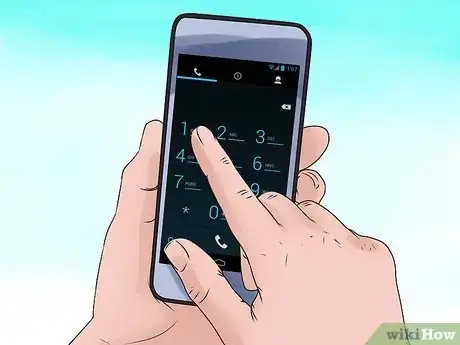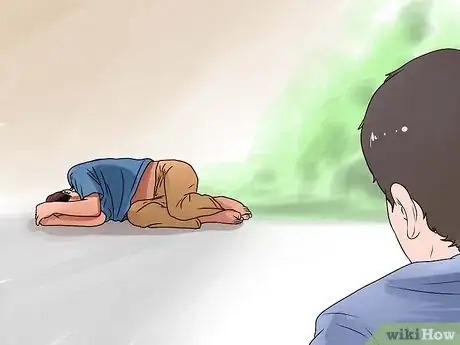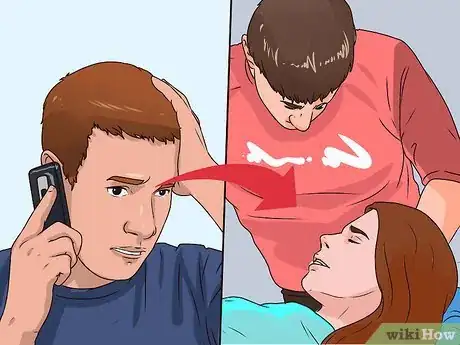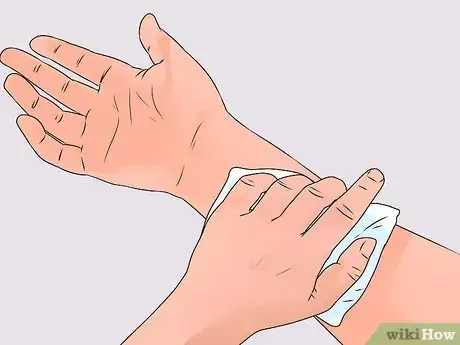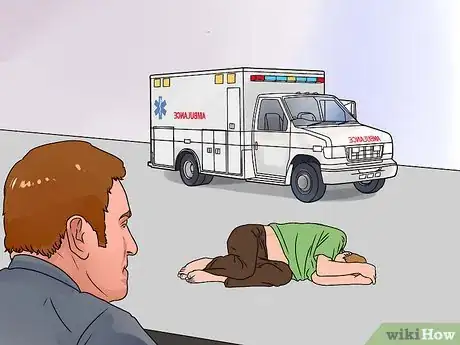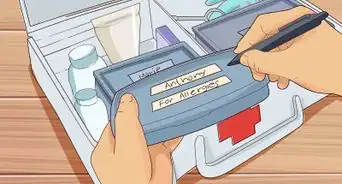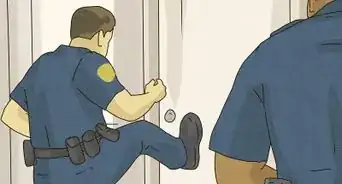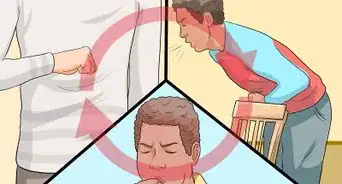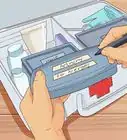This article was co-authored by Chris M. Matsko, MD. Dr. Chris M. Matsko is a retired physician based in Pittsburgh, Pennsylvania. With over 25 years of medical research experience, Dr. Matsko was awarded the Pittsburgh Cornell University Leadership Award for Excellence. He holds a BS in Nutritional Science from Cornell University and an MD from the Temple University School of Medicine in 2007. Dr. Matsko earned a Research Writing Certification from the American Medical Writers Association (AMWA) in 2016 and a Medical Writing & Editing Certification from the University of Chicago in 2017.
This article has been viewed 200,113 times.
If you are ever in a life-threatening emergency, the ability to call an ambulance is a very useful skill. It is important to always have the emergency number for your area memorized. Being composed and prepared to help could save a life.
Steps
Calling the Ambulance
-
1Compose yourself. Take a deep breath and take a few seconds to collect yourself. While time is of critical importance, you can’t help if you are hysterical.[1]
-
2Know the number. Emergency service numbers depend on which country you live in. You should always have the number to emergency services in your area memorized. After all, it is only three numbers. Look below for a list of some well-known emergency service numbers.
- Dial 911 (US/Canada)
- Dial 999 (UK)
- Dial 000 (Australia)
- Dial 112 (Europe)
- Dial 119 (Japan)
- Other countries and continents have their own numbers, which can be found in this article.
Advertisement -
3Ask the operator for an ambulance. The operator will want to know what type of help you need. In this case, make it clear that there has been a medical emergency and that you need an ambulance immediately. The operator will send the all necessary units to assist you.[2]
- If the injury happened during the committing of a crime, you will also need police officers sent to your location.
- If the injury occurred as the result of a fire or car accident, you will likely need firefighters to come to the location as well.
-
4Give the operator details. The operator will ask you a number of questions so that he can inform the proper parties about the situation. When asked, be prepared to provide the operator with the following information:[3]
- Your location.
- The number of the phone you are calling from, if you know it.
- If you are in a public place- give the operator the nearest intersection or landmark (example First and Main street).
- Tell them your name, the injured person's name and why you need an ambulance. Relate as much medical history as you know.
-
5
-
6Be prepared to assist. The emergency responders may ask you to help them on the scene when they arrive. Stay calm and collected and follow any instructions the first responders give to you. You may be asked to back away from the scene of the injury and wait for further instructions. If this is the case, do not interfere with emergency responders.
Spotting Emergencies
-
1Only call emergency services when they're really needed. As a general rule, if someone is fully conscious and able to walk there's no need for an ambulance, though they may need to go to the hospital. Only call in scenarios that require on-the-spot medical attention.
- Minor scrapes, cuts, or bruises are not emergencies.
- A broken bone, while it can be dangerous, is often not a “life-threatening” emergency.
-
2Err on the side of caution. If you are ever unsure about how badly a person is injured, it is better to call emergency services. You are not a trained medical professional and likely do not know how to treat or tend to serious injuries. So let the experts handle it if you unsure what you are dealing with.
-
3Look for life-threatening emergencies. It can be difficult to spot life-threatening emergencies in crisis scenarios. However, there are a few signs that you should be aware of, as they will let you know if emergency services are needed. They are:
- The victim is not breathing
- The victim is losing excessive amounts of blood
- The victim is not moving
- The victim is not responsive
- The victim is experiencing dizziness, difficulty breathing, or seems to be in shock
-
4Call first, help second. Your first instinct may be to help the injured person, but it is critical that you call for help first. Every second counts. You don’t want to waste valuable time trying to determine if you can help before calling medical professionals.[6]
Providing Assistance While Waiting
-
1Analyze the situation. After calling emergency services, there are often things you can do to assist the injured person. Analyze the situation to determine if you can do anything to help before the first responders arrive.[7]
-
2Eliminate any immediate threats. If possible, do whatever you can to remove the injured person or persons from further danger. However, it's critically important that when doing this, you don't put yourself at risk of being injured. There is already one emergency, don’t make it two.
- If the victim is bleeding a lot, apply direct pressure to the wound to stem the flow of blood. Tie a towel or shirt around the wound, then apply pressure. You can also use any available items around to create a makeshift tourniquet. A belt will do in a pinch, but is not ideal for this.
- If the injury occurred in a car accident, you may need to assist by removing the injured individual from a car that is smoking or smoldering.
- If the injured person is in a dangerous area, like a busy roadway, move her to the side of the road so that she doesn't get hit by a car or other vehicle.
- Don’t ever approach a vehicle that is already on fire and, if the injured person has suffered a spinal injury, never try to move the person yourself. You could make her injury worse or get yourself blown up.
-
3Provide CPR. If you are licensed and certified to perform CPR, you may need to do so. Check the injured person’s vital signs. If you don’t detect breathing, perform CPR. The steps are listed below. [8]
- When performing CPR, begin with chest compressions. Place the heel of your hand over the center of the chest, push down 2 inches (5.1 cm), and repeat 30 times. Make sure you pump your hands hard and fast, achieving a rate of at least 100 pushes per minute. You will be pushing down faster than once per second.[9]
- After pumping the chest 30 times, blow 2 breaths of air into the person’s lungs. To do this, gently tilt the injured individual’s head backward and lift the chin upwards. Then, form a seal between your mouth and the victim’s mouth by pinching his nose and covering their mouth with yours. When providing air, blow until you see the injured person’s chest rise up. Blow in 2 breaths each time for 1 second each. [10]
- Repeat the process for as long as necessary, pumping the chest 30 times for every 2 breaths of air you give.[11]
- If you are not familiar with CPR, it is better to allow someone else to administer it, as you could injure the victim in the process.
-
4Find help in the immediate vicinity. You may not know CPR, but someone else around the scene of the injury might. Ask people around the scene to assist you in any way they can to help the victim. If you are attempting to move an individual (without a spinal injury) ask people around the scene for help.
-
5Comfort the victim. Even if you can’t provide medical assistance, you can provide moral support. The injured person is likely to be scared or anxious. Sit with her and provide support and comfort until the responders arrive.
- Tell the person that help is on the way. Keep talking to her and keep her talking to you.[12]
- Try to help the individual relax and let her know she is not alone. If she is already on the ground, keep her lying there. If she is upright, have her lie down.[13]
- If she asks, hold the injured person’s hand or rest a hand on her shoulder to let her know you are still there and willing to help.[14]
- Listen to the injured person’s requests. Never give food or drink to a victim with unknown injuries. It may hurt more than it helps.[15]
-
6Get out of the way. Once emergency services arrive, get out of their way and stay out of their way unless otherwise instructed. They are trained professionals who are prepared to respond to emergencies, but they do not need any distractions from you.
- In the case of an injury you witnessed, police will likely pull you away from the scene of the injury to ask you questions about what you saw. Follow the officers’ instructions and answer any questions you can while paramedics deal with the injured person.
Expert Q&A
-
QuestionI am currently researching information on properly receiving an Ambulance on a work site. The intent is to design a protocol that would reduce the time it takes an Ambulance to reach the victim when it arrives on site. Can you provide me some direction on this research?
 Chris M. Matsko, MDDr. Chris M. Matsko is a retired physician based in Pittsburgh, Pennsylvania. With over 25 years of medical research experience, Dr. Matsko was awarded the Pittsburgh Cornell University Leadership Award for Excellence. He holds a BS in Nutritional Science from Cornell University and an MD from the Temple University School of Medicine in 2007. Dr. Matsko earned a Research Writing Certification from the American Medical Writers Association (AMWA) in 2016 and a Medical Writing & Editing Certification from the University of Chicago in 2017.
Chris M. Matsko, MDDr. Chris M. Matsko is a retired physician based in Pittsburgh, Pennsylvania. With over 25 years of medical research experience, Dr. Matsko was awarded the Pittsburgh Cornell University Leadership Award for Excellence. He holds a BS in Nutritional Science from Cornell University and an MD from the Temple University School of Medicine in 2007. Dr. Matsko earned a Research Writing Certification from the American Medical Writers Association (AMWA) in 2016 and a Medical Writing & Editing Certification from the University of Chicago in 2017.
Family Medicine Physician You might want to partner with a computer company to help with GPS and navigation of the ambulance. This will help determine the shortest and fastest route.
You might want to partner with a computer company to help with GPS and navigation of the ambulance. This will help determine the shortest and fastest route. -
QuestionI think I need to go to the hospital because my mental health has been terrible. I have been hallucinating a ton, and also feel like harming myself or others. Should I call an ambulance, or just stay home? Or maybe just have my mom drive me there?
 Chris M. Matsko, MDDr. Chris M. Matsko is a retired physician based in Pittsburgh, Pennsylvania. With over 25 years of medical research experience, Dr. Matsko was awarded the Pittsburgh Cornell University Leadership Award for Excellence. He holds a BS in Nutritional Science from Cornell University and an MD from the Temple University School of Medicine in 2007. Dr. Matsko earned a Research Writing Certification from the American Medical Writers Association (AMWA) in 2016 and a Medical Writing & Editing Certification from the University of Chicago in 2017.
Chris M. Matsko, MDDr. Chris M. Matsko is a retired physician based in Pittsburgh, Pennsylvania. With over 25 years of medical research experience, Dr. Matsko was awarded the Pittsburgh Cornell University Leadership Award for Excellence. He holds a BS in Nutritional Science from Cornell University and an MD from the Temple University School of Medicine in 2007. Dr. Matsko earned a Research Writing Certification from the American Medical Writers Association (AMWA) in 2016 and a Medical Writing & Editing Certification from the University of Chicago in 2017.
Family Medicine Physician If you feel like hurting yourself and other you should call an ambulance immediately. If you are having thoughts of harm this is not something that you should wait on, given your current mental health situation.
If you feel like hurting yourself and other you should call an ambulance immediately. If you are having thoughts of harm this is not something that you should wait on, given your current mental health situation.
Warnings
- The emergency telephone operators are people. While they expect a level of concern and panic from the person on the phone, getting angry with him; swearing at or insulting him is not an appropriate response. If you abuse the emergency service operators, you can be charged with the commission of a crime, regardless of whether or not it happened in a crisis situation.⧼thumbs_response⧽
- Don't hang up until you are instructed to do so by the operator.⧼thumbs_response⧽
- Always check the injured person's wrists and neck for a medical tag. These can be gold or silver but should have a red "medic" symbol on them (a winged-staff with two snakes). Medic alert tags may let you know about medical problems, medications, or drug allergies.⧼thumbs_response⧽
- Don't make a false ambulance call. Doing so wastes community resources and risks the lives of people who actually need emergency medical help. Also, it's illegal, you can be traced directly to the phone you're using, and you will get in trouble.⧼thumbs_response⧽
References
- ↑ http://www.english-online.at/health_medicine/first-aid/first-aid-treatment.htm
- ↑ http://www.english-online.at/health_medicine/first-aid/first-aid-treatment.htm
- ↑ http://www.english-online.at/health_medicine/first-aid/first-aid-treatment.htm
- ↑ http://www.english-online.at/health_medicine/first-aid/first-aid-treatment.htm
- ↑ http://www.english-online.at/health_medicine/first-aid/first-aid-treatment.htm
- ↑ http://www.english-online.at/health_medicine/first-aid/first-aid-treatment.htm
- ↑ http://www.english-online.at/health_medicine/first-aid/first-aid-treatment.htm
- ↑ http://depts.washington.edu/learncpr/quickcpr.html
- ↑ http://depts.washington.edu/learncpr/quickcpr.html
- ↑ http://depts.washington.edu/learncpr/quickcpr.html
- ↑ http://depts.washington.edu/learncpr/quickcpr.html
- ↑ http://www.english-online.at/health_medicine/first-aid/first-aid-treatment.htm
- ↑ http://www.english-online.at/health_medicine/first-aid/first-aid-treatment.htm
- ↑ http://www.english-online.at/health_medicine/first-aid/first-aid-treatment.htm
- ↑ http://www.english-online.at/health_medicine/first-aid/first-aid-treatment.htm

